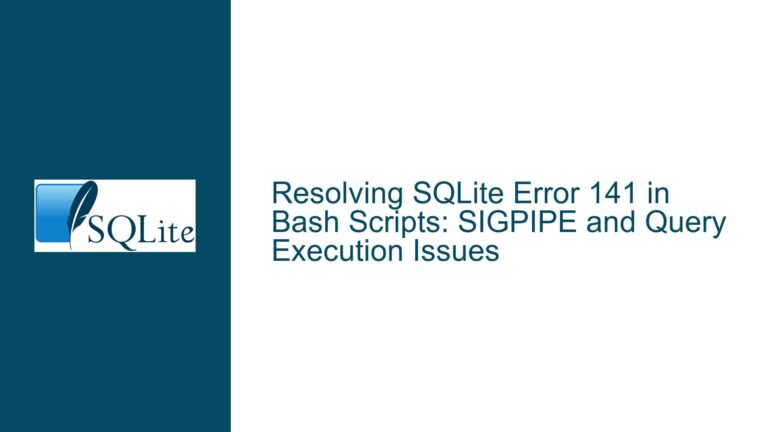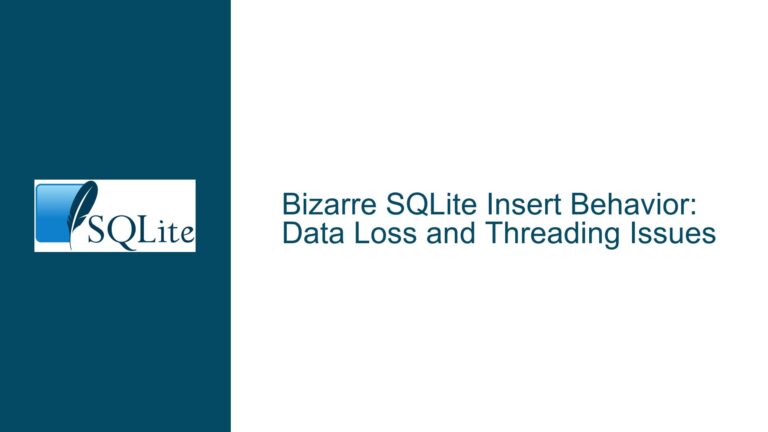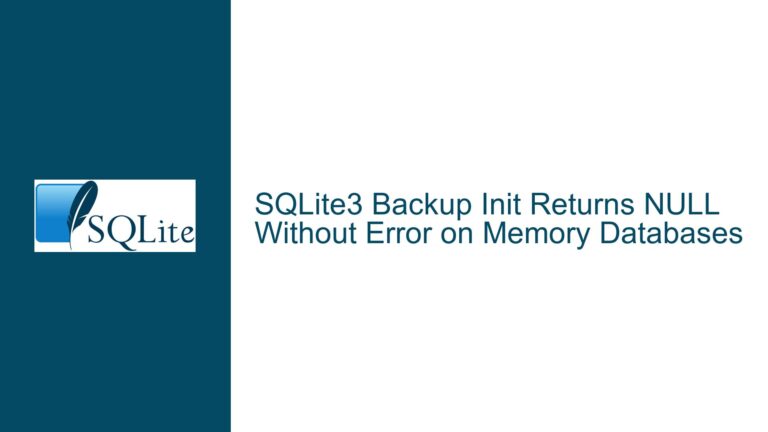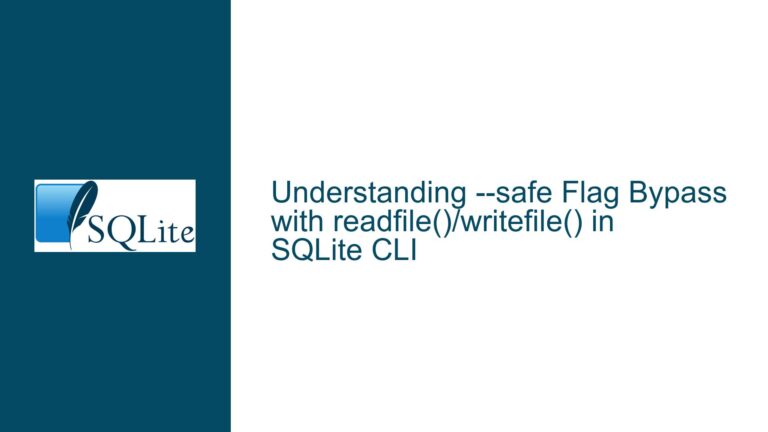Suppressing SQLite3 CLI Version and Help Messages on Startup
Understanding the SQLite3 CLI Startup Message Behavior
When launching the SQLite3 command-line interface (CLI) in its default interactive mode, users encounter two lines of text printed to the terminal before the input prompt:
SQLite version 3.27.2 2019-02-25 16:06:06
Enter ".help" for usage hints.
sqlite>
These lines serve as an informational header, displaying the SQLite library version linked to the CLI and a brief hint about accessing built-in help documentation. While this behavior is intentional and useful for most users, specific workflows—such as scripted automation, educational demonstrations, or log file cleanliness—may require suppression of these messages.
The core issue arises from the CLI’s design: it distinguishes between interactive and non-interactive modes based on whether standard input is connected to a terminal. In interactive mode (terminal input), the startup messages are unconditionally printed. Attempts to suppress them using existing flags (e.g., -noheader) fail because these flags control query output formatting, not startup behavior. This mismatch between user expectations and CLI functionality creates confusion.
Key Factors Influencing Startup Message Visibility
1. Misinterpretation of the -noheader Flag
The -noheader flag disables column headers in query results (e.g., SELECT statements). It has no effect on startup messages because these are unrelated to query output. Users often conflate these two concepts, assuming that suppressing headers in query results would also silence informational banners.
2. Interactive vs. Non-Interactive Mode Detection
The SQLite3 CLI determines its operational mode by checking if standard input (stdin) is a terminal. If input is detected from a terminal (interactive mode), the startup messages are printed. If input is piped from a file, another process, or redirected (non-interactive mode), the messages are omitted. This design prioritizes usability for human operators but complicates automation workflows where clean output is critical.
3. Lack of Built-in Suppression Flags
Unlike other command-line tools (e.g., mysql --silent), SQLite3 lacks a dedicated flag to disable startup messages. The absence of options like --nologo or --quiet forces users to employ workarounds that alter the CLI’s mode or modify its source code.
4. Static Linking and Version Identification
The CLI is statically linked to the SQLite library, meaning each binary includes a specific library version. Developers and system administrators often rely on the startup message to verify which binary (and thus which library version) is executed, especially when multiple installations exist (e.g., system-wide vs. user-compiled binaries). This use case explains why unconditionally suppressing startup messages is discouraged by default.
Strategies for Disabling Startup Messages and Their Trade-offs
1. Forcing Non-Interactive Mode with Input Redirection
Mechanism:
By redirecting standard input from a source other than a terminal, the CLI switches to non-interactive mode, suppressing startup messages.
Implementation:
- Pipe Input from a File:
echo "SELECT 1;" | sqlite3This executes the command without printing version information.
- Use a Here Document:
sqlite3 <<EOF SELECT 1; EOF - Redirect from
/dev/null(Unix-like systems):sqlite3 < /dev/nullThis opens an interactive session but suppresses messages by tricking the CLI into non-interactive mode.
Trade-offs:
- Loss of interactive features (e.g., input prompts, line editing).
- Commands must be predefined or piped, limiting flexibility.
2. Leveraging the --batch Flag for Scripted Execution
Mechanism:
The --batch flag forces the CLI into non-interactive mode, disabling startup messages, input prompts, and interactive command processing.
Implementation:
sqlite3 --batch "your_database.db" "SELECT * FROM your_table;"
For multi-command workflows, use a command file:
sqlite3 --batch your_database.db ".read commands.sql"
Trade-offs:
- Disables readline support, making manual input cumbersome.
- Removes continuation prompts (
...>), which may confuse users during multi-line command entry.
Workaround with rlwrap:
Combine --batch with rlwrap to restore line editing:
rlwrap -S 'sqlite> ' sqlite3 --batch
This provides a faux prompt and history navigation but does not fully replicate interactive mode behavior.
3. Modifying the SQLite3 CLI Source Code
Mechanism:
The startup messages are hardcoded in the CLI’s source file (shell.c.in). Commenting out the relevant printf statements and recompiling produces a custom binary that skips these messages.
Steps:
- Locate the Source Code:
Download the SQLite amalgamation source or clone the Fossil repository. - Edit
shell.c.in:
Find the lines:if( stdin_is_interactive ){ printf("SQLite version %s %s\n", sqlite3_libversion(), sqlite3_sourceid()); printf("Enter \".help\" for usage hints.\n"); }Comment out the
printfstatements:if( stdin_is_interactive ){ //printf("SQLite version %s %s\n", sqlite3_libversion(), sqlite3_sourceid()); //printf("Enter \".help\" for usage hints.\n"); } - Recompile the CLI:
Follow platform-specific compilation instructions. For Unix-like systems:gcc -o sqlite3 shell.c sqlite3.c -lpthread -ldl
Trade-offs:
- Requires technical expertise to compile from source.
- Custom binaries must be maintained separately from system packages.
- Loses version information critical for debugging version-specific issues.
4. Feature Request for a --nologo Option
Advocacy:
Propose a new command-line flag (e.g., --nologo or --quiet) to the SQLite development team. This would allow users to suppress startup messages without altering the CLI’s operational mode.
Implementation Example:
Modify shell.c.in to honor a new flag:
// Global variable
int showLogo = 1;
// Parse command-line options
if( strcmp(zArg,"--nologo")==0 ){
showLogo = 0;
}
// Conditional printing
if( stdin_is_interactive && showLogo ){
printf(...);
}
Challenges:
- Requires consensus from the SQLite maintainers.
- Must balance simplicity with the project’s philosophy of minimalism.
5. Environment Variable Workarounds
Mechanism:
Use shell scripting to strip startup messages from the CLI’s output.
Implementation:
sqlite3 2>&1 | tail -n +3
This pipes all output (including stderr) through tail to skip the first two lines.
Trade-offs:
- Fragile if error messages or warnings appear before startup lines.
- Introduces external dependencies (e.g.,
tail).
6. Wrapper Scripts for Transparent Suppression
Mechanism:
Create a shell script that invokes sqlite3 while filtering out unwanted lines.
Implementation (sqlite3-quiet):
#!/bin/bash
{
sqlite3 "$@" 2>&1 >&3 | head -n 2 >/dev/null
} 3>&1
This redirects stdout to file descriptor 3, filters stderr to remove the first two lines, and forwards the rest.
Trade-offs:
- Complexity increases with error handling.
- May interfere with interactive features.
Final Recommendations
- Automation/Scripting: Use
--batchmode or input redirection for clean output. - Interactive Use with Custom Prompts: Combine
--batchwithrlwrapfor a balance of cleanliness and usability. - Source Modification: Ideal for controlled environments where version information is irrelevant.
- Community Advocacy: Push for a
--nologooption in future SQLite releases to address this gap.
By understanding the SQLite3 CLI’s design constraints and employing these strategies, users can achieve the desired output cleanliness while respecting the tool’s intended functionality.






